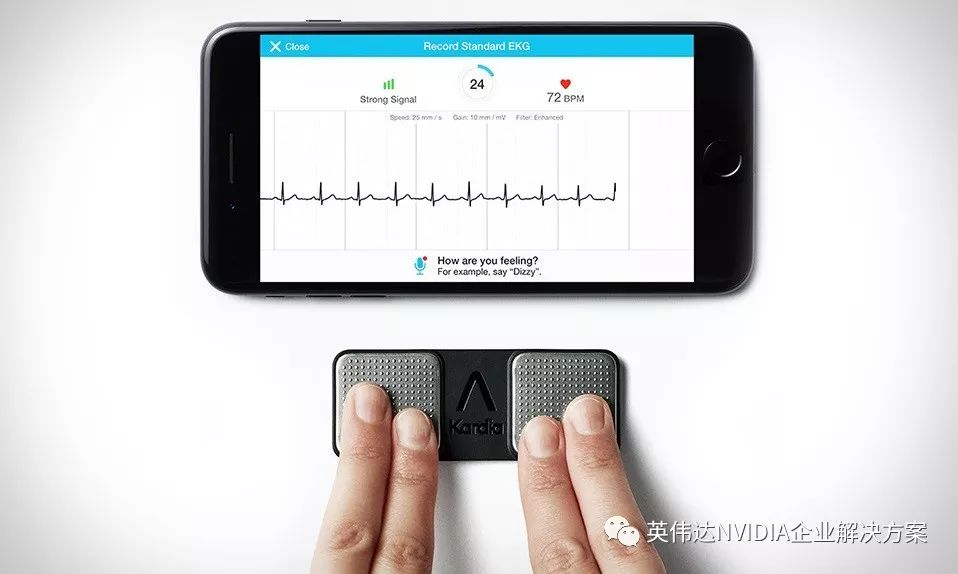AI is fast becoming a human savior. Heart disease is known as "the world's number one killer", and recently, two studies from the business community and academia have increased the possibility of conquering the disease.

The Stanford team led by Wu Enda and a startup in Silicon Valley are using the power of AI to improve heart abnormalities and improve diagnostic accuracy.
Medical device manufacturer AliveCor is located in Mountain View and is currently working on deep learning and AI algorithms so that people can monitor their heart rate through the built-in sensors of the Apple Watch, even through the application and specially designed straps for instant ECG ( EKG) check.
A KardiaMobile device developed by AliveCor has received widespread attention in the EKG industry, allowing users to record and analyze EKGs with smartphone applications. AliveCor trained a set of NVIDIA Tesla GPUs on AWS on the basic deep learning model developed five years ago. This model can generate a cardiac profile for the user and then compare it to the future EKG.
In addition, the companion app automatically detects if new users are using the device, ensuring consistency and integrity of the primary user information.
Determine when an EKG check is required

The new FDA-approved KardiaBand from AliveCor has radically reduced the size of the KardiaMobile, can be embedded in the Apple Watch strap and integrated with the many sensors in the watch. However, Frank Petterson, the company's vice president of engineering, said the AI ​​program called SmartRhythm is the real innovation behind KardiaBand.
SmartRhythm is trained on the NVIDIA Tesla V100 Data Center AI Accelerator to analyze the user's current activities and other factors and heart rate. According to the analysis results, many problems can be identified, such as whether an abnormal data appears as an accidental situation caused by the environment at the time, or an early warning of potential diseases in the future.
Petterson said: "We can make the neural network run once every five seconds on the user's Apple Watch within 24 hours, and upload and classify all heart rate and activity data. The algorithm can infer whether the data represents a reasonable situation, if not If reasonable, the user is reminded to record the EKG."
Petterson said they will work with the Mayo Clinic to understand electrolyte concentrations through EKG and to prevent congenital long QT syndrome (which can cause athletes and other seemingly healthy people to faint or even die).
Petterson pointed out that "the useful data in EKG is so large that it is unimaginable."
The team led by Wu Enda is attacking EKG research
At the same time, a team of computer scientists at Stanford University, under the leadership of part-time professor Wu Enda (formerly Baidu's chief scientist), used the algorithm that introduced AI to achieve automatic reading and analysis of EKG. They hope to speed up the diagnosis of arrhythmia and improve diagnostic accuracy, allowing medical staff to focus on solving more difficult problems or spending more time on treating patients.
Awni Hannun, a doctoral student at the Wu Enda team, said: "In hospitals where EKG examinations are performed, doctors still read the results manually."
Hannun and his team are working with iRhythm. iRhythm produces wearable cardiac monitoring devices for detecting abnormal cardiac activity and has a large amount of EKG historical data. The two teams decided to work together to automate the arrhythmia detection process.
Since then, they have collected a database of more than 30,000 patients (including 60,000 anonymous 30-second EKGs) and optimized the 34-layer deep learning model with a set of NVIDIA GPUs from Stanford University.
A paper published last year details the model, which so far distinguishes between 14 different arrhythmias, allowing cardiologists to have a clearer picture of the patient's heart. Analysis of the results of the EKG records using this model will be compared to the accuracy of the analysis of the cardiologist. The model performs better than most cardiologists. However, Hannun said that as long as any cardiologist performs better than the model, the team will continue to refine their algorithms.
Ningbo Autrends International Trade Co.,Ltd. , https://www.mosvapor.com